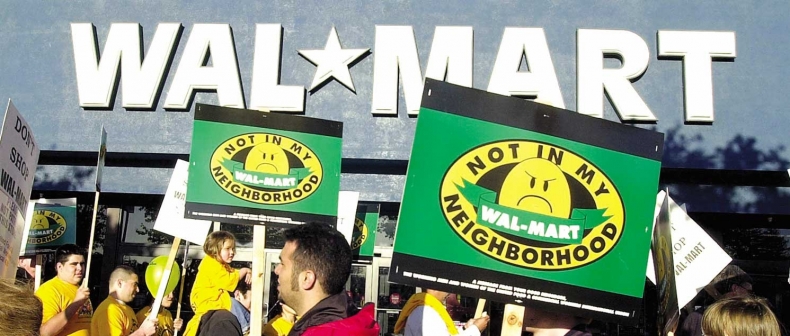
Residents protest Walmart in Washington, DC.
By Jess Davidson
RioCan’s proposal to construct a new, larger-than -current-zoning-guidelines-allow, three-storey commercial building on the former site of Kromer Radio at Bathurst and Nassau has proved a contentious issue in Toronto. The kicker, of course, being that the development, as it stands now, will include Walmart as the anchor tenant.
If all goes according to RioCan’s plan, the structure will have approximately 12,000 square metres of retail space across eight to 10 commercial units on the ground floor, with Walmart on the upper floors. Given its proximity to the largely anti-establishment community of Kensington Market, this has been met with rather fierce opposition and has led to the establishment of community groups working to fight this development.
Maggie Helwig, a member of Friends of Kensington Market, a group mobilized to stop car-centric big box development and preserve the walkability of one of Toronto’s most cherished neighbourhoods, aims to keep the community free of large-scale retail, and echoes comments that have been made by the City of Toronto’s chief planner that the Market’s surrounding area is marked by “fine grain” development.
“It’s a fine grain neighbourhood–we have small-scale housing, we have small-scale businesses, we have a very strong sense of neighbourhood and community in all of these areas. [The neighbourhood’s] built on that careful meshing of a lot of small pieces,” she explains. “Suddenly dumping a large Big Box development in the middle of a delicate ecosystem is a problem.”
Helwig, who is also the priest-in-charge at Kensington Market’s Church of Saint Stephen-in-the-Fields, is concerned about the impact on the community’s marginalized and vulnerable population.
“This includes small business owners already struggling or on the edge, low-wage earners who could be really affected by Walmart driving the labour market down, and the large number of street-involved homeless, marginally housed, or extremely poor people for whom Walmart is financially out of reach,” she says.
One of her main concerns is that a large retail centre, such as a Walmart, won’t follow in the footsteps of local business owners who manage and cope with the these groups with some sensitivity.
“The small scale of the businesses and the small scale of the residences allows for this. I see the small business people really having relationships with the vulnerable and the marginalized.”
She is not alone in this concern, as well as a host of others. As any research on the impact, or potential impact, of the introduction of a Walmart to a community will uncover, the same economic and social issues seem to come up time and time again in the anti-Walmart narrative: the negative impact on local small businesses; increased traffic levels in the surrounding area; various types and degrees of pollution, from air and water, to noise and light; a potential decrease in surrounding property and land value; and a burden on wages.
Dominique Russell — whose name will be familiar to anyone following this story as she launched the now 87,000+ signature strong petition to keep Walmart out of the community — says this is why people oppose the development.
“One of the reasons that people are really concerned about Walmart is that the effect has been studied and seen,” she says, citing a tendency for independent stores to start to disappear after the giant retailer enters a community. “That’s a real red flag, and probably why so many people are so concerned, based on the evidence of the Walmart Effect.”
For now, the threat of this happening in Kensington Market and the surrounding area has been diminished, as a bylaw has been passed that freezes any new retail development along Bathurst Street between Dupont and Queen for the next year. However, this is not a long-term solution, and the saga shall continue.
This ongoing battle is only the latest in a long string of clashes that pits Walmart against heated communities fighting to keep the corporation out. As the world’s largest retailer, it is clear that the behemoth corporation typically wins the battle, a Goliath defeating the Davids in its path. But, once in a while, David fights back and wins.
Communities that have successfully kept Walmart at bay include pockets in-and-around New York City, Boston, Detroit, San Francisco, Seattle, and, notably, right here at home in the east-end neighbourhood of Leslieville. But it’s not just urban centres with liberal and democratic strongholds that have kept the southern, conservative retailer at bay. Kansas City suburbs, Wyoming outposts, and other small towns in North America and abroad have seen success lobbying to keep towns Walmart-free.
While each community has its own story, two that are worth a closer look include an example from New York State, and one a bit closer to home in Guelph.
A Cooperative Community Movement to Defeat a Retail Giant
In Saranac Lake, New York, population 5,000, the community was faced with the prospect of a 120,000 square foot Walmart moving into town. In hopes of preserving the town’s heritage and local values, residents said no to the development, and instead came together to open their own community department store by purchasing shares in a newly-formed company priced at $100 each.
At a much more reasonable 4,000 square feet, the aptly named The Community Store is locally-owned by community members. Like other community-owned stores, the business was designed by residents to meet specific local shopping needs at reasonable prices. They sell everything from Eddie Bauer tops for $6.99 to $10 backpacks for back-to-school, at prices that clearly keep pace with what Walmart can offer, though they do so through low overhead and community support, and not on the backs of international workers.
The focus is on quality, recognizable brands, as well as products that are eco-friendly, locally-made, and that, for the most part, don’t directly compete with what other local businesses are selling. They also pride themselves on being a good employer and on providing a quality work environment.
By all accounts, this store stands in stark contrast to Walmart, and the community seems to be responding positively.
But lest you think this story has a happy ending, let’s turn now to an example a little closer to home.
Guelph Against Goliath
Though one might not naturally see the parallels between this Southwestern Ontario community’s fight against Walmart and the current fight in Toronto, the two examples have many similarities. Bearing in mind that the current Toronto campaign is based in Kensington Market, both involve tight-knit communities, socially progressive districts, and an area that sees itself as a bit different, slightly against the grain.
Ben Bennett, author of Guelph Against Goliath, and member of Residents for Sustainable Development, a coalition formed to “put a lid on” large-scale retail development, sums up the struggle nicely in the introduction of the book:
“The six years of community organizing and participation that are the central theme of this book were not so much driven by a desire to deny others their shot at cheap underwear so much as by a sense of ‘whose community is this, anyway?’”
Like Toronto, the city had an Official Plan, and just as we’re experiencing now, developers came in and tried to tweak the plan. There was a push toward rezoning in order to accommodate Big Box retail, a request rejected by City Council before Walmart’s developers took it to the OMB.
While this was unfolding, the Residents for Sustainable Development worked to keep Walmart at bay. The group held weekly meetings, manned an information booth at a farmer’s market Saturday mornings, drew up a petition, lobbied city council, hired legal representation, and rolled out pamphlet and poster campaigns (this was before the days of social media). The group also ensured their voice was heard at all of the standing room-only community consultations, many of which stretched on for more than four hours at a time, packed with community members who came to share the same message.
Ultimately, the campaign to keep Walmart out of the community was not a success as the OMB ruled to allow the Official Plan to be amended, setting the stage for development. Five years after Bennett’s book was published, the coalition and community was still organizing, still fighting, but in 2006 Walmart got final approval. Today, after appeals by the community to the OMB decision, as well as a charter challenge, Guelph is home to a 135,000 square foot Walmart.
“While the war was finally lost, we kept Walmart at bay for 10 years, and the community organizing that was part of this meant that in the subsequent municipal election–fall 2006–most of the pro-Walmart councillors were tossed out and replaced by a progressive council.”
Can Walmart Really be Beaten?
While some communities have, seemingly, defeated the giant corporation, for others, the inevitable was simply delayed. Time will tell what the case will be for the Kensington Market community, though for now, the group can take some inspiration from others who have found value in the fight.
Madeline Janis, national policy director of the Los Angeles Alliance for a New Economy, a group involved in successfully preventing the massive retailer’s move into the Los Angeles-area community of Inglewood, reminds those fighting that “It is possible for communities and workers to stand up to the behemoth and win.”
“Walmart experienced in 2004 a taste of what happens when a low-income community stands up and demands respect. Walmart tried and failed to win blanket approval to build a 17 football field sized superstore without taking into consideration the needs and aspirations of the local community.”
Today, Inglewood is still without a Walmart, serving as a beacon for other communities aiming for the same outcome.
“Communities value more than cheap prices and convenience. People understand that having responsible businesses and good jobs that let workers provide for their families and contribute back to community is central to strong and healthy communities,” says Aiha Nguyen, LAANE’s director of Good Grocery Stores, a campaign focused on trying to keep Walmart out of LA’s Chinatown.
“The key to winning the fight and debate around Walmart is on the ground, through organizing, but also on a macro level, by holding elected leaders accountable for building strong communities,” Nguyen explains. “What Inglewood taught us is that broad policies that values and place good jobs and local communities first are critical to making sure communities have the tools to push back against multinational corporations like Walmart.”
According to Susan Schutta, senior director of Corporate Affairs at Walmart Canada, the company conducts thorough research to determine where there is consumer desire for a Walmart store, and pays attention when a community makes it clear that the retailer is not welcome.
“This includes a great deal of listening to ensure all voices are heard, and all points of view are taken into account.”
She also points out that the company does research upfront to determine if a Walmart is suitable for a proposed site, raising the very points community groups tend to attack.
“Walmart defers to municipal planning departments/processes to ensure important development issues such as streetscape, parking, vehicular access, transportation reports, economic impact reports and zoning are thoroughly considered,” she explains. “These are all considerations which affect the decision regarding whether the proposed development is appropriate for the site.”
Though at this point there’s no telling if the current local fight will go the way of Inglewood, and keep the corporation out; the way of Saranac Lake, and come up with a community-minded alternative; or follow the same fate as Guelph, and simply delay the retailer’s entrance, for those who have been there it’s a battle with pursuing.
“The system is such that the odds of winning this over the long term were not very favourable, but you have to stand up to bullies,” says Bennett. “You may not win, but it makes it harder for them to bully others next time–just look at Leslieville.”
For Kensington Market locals involved in the fight, it is a battle worth pursuing.
As Russell puts it, it’s now or never.
“People mobilize to ensure that a Walmart doesn’t go in because once they’re in, it’s too late.”
____
Jess Davidson is a Toronto-based writer. Follow her on Twitter @JessDavidson
For more, follow us on Twitter @TorontoStandard and subscribe to our newsletter.














